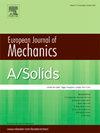梯度纳米晶NiTi形状记忆合金相变与塑性行为的原子研究
IF 4.2
2区 工程技术
Q1 MECHANICS
引用次数: 0
摘要
通过晶粒细化提高NiTi形状记忆合金(SMA)的强度和抗疲劳性能已成为研究的热点。然而,细晶强度的增加会显著抑制相变,降低可恢复变形幅度。梯度晶粒分布的引入可以同时保持细晶粒的强度和粗晶粒的延展性。本研究采用分子动力学方法模拟了梯度纳米晶NiTi SMA的相变和塑性变形行为。模拟结果表明,梯度纳米晶NiTi SMA的应力诱导相变过程在空间上是均匀的,而晶界梯度分布的应力促进了细晶和粗晶区域的同步相变。相反,温度诱导的相变表现为局域化行为。梯度纳米晶NiTi的超弹性行为表现出明显的拉压不对称性,这是由不同加载条件下产生的不同类型的马氏体变体所主导的。随着梯度速率的增大,晶界处的塑性变形减小,残余应变减小。同时,梯度速率的增大削弱了对位错滑移的抵抗,促进位错扩散,产生堵塞现象,从而提高了屈服强度。本研究基于原子尺度分析揭示了梯度纳米晶NiTi SMA结合优异超弹性和高屈服强度的微观机理,并通过调节晶粒梯度分布验证了其力学性能的可设计性,为高性能NiTi SMA的开发提供了理论基础。本文章由计算机程序翻译,如有差异,请以英文原文为准。
Atomistic study of phase transformation and plastic behaviors of gradient nanocrystalline NiTi shape memory alloy
Enhancing the strength and fatigue resistance of NiTi shape memory alloy (SMA) through grain refinement has become a hot research topic. However, the increase in strength of fine grains will significantly inhibit the phase transformation and reduce the recoverable deformation amplitude. The introduction of gradient grain distribution can simultaneously maintain the strength of fine grains and the ductility of coarse grains. In this study, the phase transformation and plastic deformation behavior of gradient nanocrystalline NiTi SMA are simulated using the molecular dynamics method. The simulation results indicate that the stress-induced phase transformation process in gradient nanocrystalline NiTi SMA is spatially homogeneous, while the gradient-distributed stress at grain boundaries promotes synchronous phase transformation in both fine-grained and coarse-grained regions. Conversely, the temperature-induced phase transformation exhibits localized behavior. The superelastic behaviour of gradient nanocrystalline NiTi exhibits a significant tensile-compressive asymmetry, which is dominated by different types of martensitic variants produced by different loading conditions. Whereas, as the gradient rate increases, the plastic deformation at the grain boundaries decreases and the residual strain decreases. Meanwhile, the increase of gradient rate weakens the resistance to dislocation slip, promotes dislocation proliferation and generates plugging phenomenon, and thus enhances the yield strength. In this study, the microscopic mechanism of gradient nanocrystalline NiTi SMA combining excellent superelasticity and high yield strength is revealed based on atomic scale analysis, and the designability of their mechanical properties is verified by regulating the grain gradient distribution, which provides a theoretical basis for the development of high-performance NiTi SMA.
求助全文
通过发布文献求助,成功后即可免费获取论文全文。
去求助
来源期刊
CiteScore
7.00
自引率
7.30%
发文量
275
审稿时长
48 days
期刊介绍:
The European Journal of Mechanics endash; A/Solids continues to publish articles in English in all areas of Solid Mechanics from the physical and mathematical basis to materials engineering, technological applications and methods of modern computational mechanics, both pure and applied research.

 求助内容:
求助内容: 应助结果提醒方式:
应助结果提醒方式:


